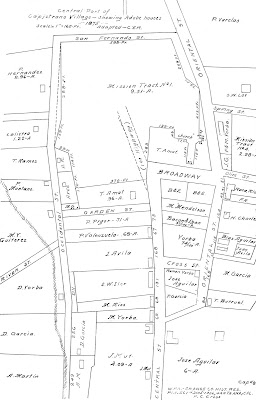 |
| Orange County Title Co., 1953 (Photo courtesy CSUF Special Collections) |
 |
| Same scene in 2019. (Photo by C. Jepsen) |
Joshua D. Parker, brought his family to the town of Orange around 1872. His four boys – Millard, Josh, Charles Edward (“C.E.”), and Clarence all have interesting biographies worthy of more depth than I can give them here.
C.E. Parker started a nursery that was an early source for Orange County's walnut and citrus groves. He moved to Santa Ana in the 1880s, became a partner in a local granary, and was behind the push for Santa Ana to bring adopt the new technologies of electric street lights and telephones.
 |
| Three generations of leadership (L to R): C.E. Parker, George A. Parker, and D.P. Kennedy. (Courtesy First American) |
Two companies sprang up to fill this need: Santa Ana Abstract Co. and the Orange County Abstract Co. In 1892, C.E. Parker bought part of Santa Ana Abstract Co. and, with his partners, merged it with their rival company in 1894.
Thus began the Orange County Title Co. (later renamed First American Title). In 1924, the company became one of the first in California to issue title insurance.
“…The complete story of land titles in Orange County is told in the vast archives of the Orange County Title Company,” explained First American’s book, Orange County: Indians to Industry, in 1963. “Glimpses of the... gracious mode of life in the early days of the county may be had by perusal of the volumes in which recorded documents affecting the title to property were laboriously copied by hand. Deeds stipulating payment of the purchase price of a piece of land with tallow at $1.20 per ‘arroba’ and hides at $2.00 each often paint vivid word pictures of the county’s pioneer past. Marriage ‘contracts,’ wills and other documents offer exciting insight into the sacrifices, hopes and efforts that went into the making of the county.”
 |
| This was O.C. Title's third location in Downtown Santa Ana (circa 1900). The 1931 building now sits on this and surrounding properties. (Courtesy First American) |
George’s son, attorney Ted Parker, began collecting photos of early Orange County from the scrapbooks of pioneer families, from the studios of photographer Ed Cochems, and from anywhere else he could find them. Today, the First American Historical Collection includes over 12,500 images – many of them iconic.
 |
| Architectural rendering from the Los Angeles Times, Jan. 19, 1930. |
"Allen Ruoff, Los Angeles and Santa Ana architect, is preparing plans for a two-story brick and concrete office and archives vault building at the southeast corner of Fifth and Main streets, Santa Ana” announced the Los Angeles Times on Jan. 19, 1930. “...Ruoff has [also] just completed plans for a $250,000 mausoleum, chapel and crematory to be built at Santa Ana for Fairhaven Cemetery."
 |
| O.C. Title Co., 1930s. Color adjusted for emphasis. (Photo courtesy Mark Hall-Patton.) |
 |
| O.C. Title Co. building, 2019. (Photo by Chris Jepsen) |
Indeed, there was a need. But rather than building upward, First American spread out. They began in 1954 by adding a new wing featuring a modern/Jeffersonian neo-classical façade by architect Thomas F. Shoemaker. This was followed by a larger expansion in 1967 that filled the entire block and also re-clad much of their 1931 art deco building to match the neo-classical look. Some additional renovations occurred in 1977. But the original façade is probably still sitting underneath all the “frosting” even today.
 |
| The First American complex circa 1963 – between the 1954 and 1967 expansions. |
 |
| E. 4th St. at Bush St., looking west, circa 1910. Image color adjusted for emphasis. (Courtesy Tom Pulley) |
 |
| E. Fourth St. at Bush St., looking west, 2019. (Photo by Chris Jepsen) |
In any case, the campus served First American well for decades. But the entire complex was largely abandoned when First American moved into their new corporate headquarters at MacArthur Blvd. and the 55 Freeway around 2000. (They were determined to stay in Santa Ana, even if they had to go to the outskirts to find a parcel large enough.)
Around the same time, the company was renamed again to become the First American Corporation, reflecting the wider array of financial, insurance, data services and other business services they provided. In 2010, the enormous (and by now international) company was split into First American Financial Corp. and CoreLogic Inc. The latter encompassed the property information and analytics aspects of their business. In 2017, First American's total revenue was $5.8 billion.
 |
| Planned new development by Toll Brothers. (Courtesy City of Santa Ana) |
Check out the project page on the City's website, with particular attention to the Cultural Resources section of the Environmental Impact Report Technical Appendices and share your thoughts.











